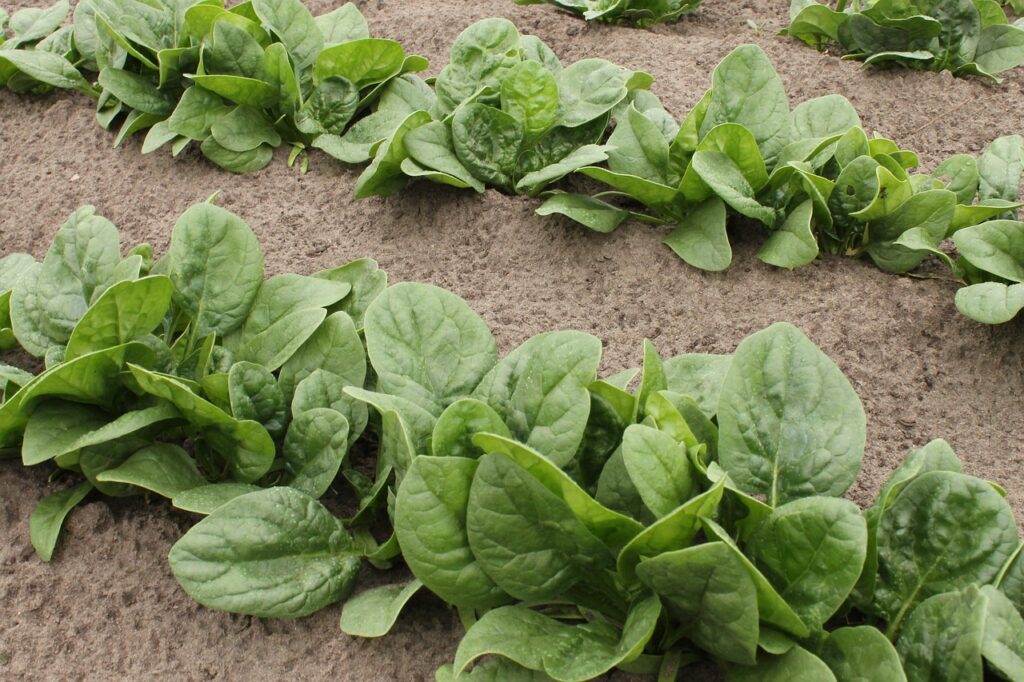Spinach is an awesome, hardy vegetable that deserves more credit than being the green that embarrasses you as you run errands after eating a delicious salad at lunch.
Seriously though, spinach is a popular, versatile crop that grows fast and should be a staple on your market farm.
Don’t believe me?
Let’s hear from some market garden experts.
This is what Pam Dawling of Sustainable Market Farming has to say about spinach:
Spinach is a wonderful crop, which grows under cool, and even cold, conditions. Here [Virginia] spinach is a fall and spring crop, with the option of overwintering the fall-planted crop under row cover for winter and early spring harvests.
Curtis Stone of The Urban Farmer says:
Spinach is a staple on my farm. I can grow a ton of it in a very small space. I sell a lot of spinach during the shoulder seasons and winters.
JM Fortier, the market gardener, also appreciates spinaches winter hardiness:
Not only is it the ultimate frost-hardy crop, but unlike Asian greens and kale greens, it is known and loved by all.
We will be drawing on the expertise of these three market garden gurus for the information provided in this article.
Why Grow Spinach?
Here are just a few reasons why you should be growing spinach on your market farm.
- Spinach grows very fast
- Ready to harvest in less than 50 days
- Popular
- Great for salad mixes
- Hardy
Varieties
For people who love heirloom veggies, the Bloomsdale varieties – Winter and Long-Standing – are reliable.
For bolt-resistance, you’re better off with hybrids.
Tyee is a popular variety and is what Pam grows exclusively.
Space is another popular smooth-leafed variety.
Some growers use Tyee for spring plantings from transplants because it is fast growing. In summer, they switch to direct seeding the more bolt-resistant, smooth-leaved Space. They sow in the evening and water frequently until the seeds germinate.
Space can grow all summer without bolting.
Other varieties that are recommended for bolt tolerance are:
- Indian Summer
- Olympia
Cold hardy varieties include:
- Samish
- Olympia
- Avon
Crop Requirements
Spinach is a cool-weather crop and is hard to germinate in warm conditions.
Like most leafy greens, it appreciates a fairly rich soil, plenty of water, good drainage, pH of 6-7, and moderately good light.
Partial shade can be an advantage once the weather starts to warm, so take this into account when planning crop layouts.
Sowing Spinach
In terms of emergence, spinach comes quickest at 59-86°F (15-30°C).
However, emergence is only half the battle with spinach.
The percentage of normal seedlings that do emerge is also vitally important.
Temperatures of 50-59°F (10-15°C) should produce plenty of normal seedlings in a reasonable 7-12 days.
Sow seeds half an inch deep. Rows can be anywhere from 3-12” apart, depending on your equipment and space available. Sowings are usually thinned to 4-6”.
In spring, Pam and team direct sow spinach or transplant from plug flats (200 cells) or bare-root transplant from a hoophouse nursery bed as early as possible.
They typically plant four rows of spinach on 4’ wide raised beds. They use rowcover until the plants are established.
Curtis Stone chooses to transplant his first crop into low tunnels, then direct seed for the rest of the season.
He plants the first field sowing around the third week of March. From there he plants spinach weekly and bi-monthly until June.
By this time, it is too hot for spinach to germinate well, so he takes a break until mid-September.
He does two more plantings that will be a fall crop, and finishes the season with an overwintered crop during the first week of October.
JM transplants all of his spinach plantings (to improve germination rates) and uses rowcovers for his first spring seeding to make it develop as early as possible.
For overwinter spinach crops, eight weeks before the first fall frost date is a good time to start planting spinach again if it’s not too hot.
You should be able to harvest this large planting from October all the way until April, or your spring planting.
If you live in a cold climate, make sure to sow your seeds earlier in order to have adequate growth before hard freezes, sowing as soon as temps are cool enough for germination.
Pam uses double hoops and rowcovers and picks spinach throughout the winter, whenever leaves are big enough.
Spinach will make some growth whenever the temp is above 40°F (5°C).
For Curtis’ overwinter crop, he plants five rows that can be harvested multiple times during the cool months.
As the weather gets warmer, the crop starts to lose flavour and shape.
Spinach is at its best during cool months, and even in winter has a sweet flavour.
Transplanting
Spinach transplants very easily bare-root or from plug flats, so seedlings can be started in more ideal conditions than you may have outside.
Be sure to water the transplants daily until you are sure they have taken.
Growing Spinach in the Hoophouse
Spinach can grow beautifully in a hoophouse in winter.
Pam and team harvest whenever it looks big enough, working their way up and down the beds and the various plantings.
They make 6 sowings of spinach in their hoophouse between September and January. The last sowing is for transplants to be moved outdoors.
The advantage of the hoophouse open-ground sowing is that it’s quicker and less work from then on as the crops get watered along with everything else and dry out less quickly than flats do.
Pests and Diseases
Voles can be a pest, as they eat the roots. To mitigate this problem, try “Intruder” mousetraps from the hardware store baited with peanut butter or fruity bubble gum.
Diseases are not generally a problem.

Harvest
There are three main ways to harvest spinach.
Harvest by the leaf
You can harvest spinach leaf by leaf with scissors.
This has the advantage of producing an attractive product – all whole leaves.
It also is the least damaging to the plant and likely to give the highest total yield over the life of the plant.
One disadvantage is that it can be rather slow, depending on the skill of the harvester.
Buzzcut Method
This is a faster method, and the plants live to carry on producing more.
Gather the leaves and cut them all, one inch above the crown.
The plants do take longer to recover from buzz cutting than from leaf harvesting.
If you are making a salad mix, the fact that the leaves are cut might not matter.
This is a good method when time is at a premium.
Single Harvest
This is where you cut the plants, then till in the crop residue, and start again.
This is the quickest method and produces the most beautiful spinach.
Although this isn’t suitable in late fall if you hope to overwinter your spinach.
In early fall or in spring, this method has its place as a quick catch-crop before a longer-term food crop or winter crop is sown or transplanted.
Post-harvest
When washing spinach, be sure to spin-dry it well, as it must be completely dry in order to stay fresh in a sealed bag.
In these conditions, bulk spinach keeps for over a week in the cold room.
Bottom Line
Spinach is an awesome vegetable that is fairly easy to grow, can be grown all year long, and is minimally affected by pests and diseases.
Whoops, forgot to mention that it is super popular!
This is a great crop to grow in spring, fall, and winter. You can take a break during the heat of the summer and grow some lettuce and chard instead.
What’s your favourite way to use spinach? Let us know in the comments below.
I’ll go first, I love spinach in stir-frys and smoothies.
Stay Local,
Kathy & Jon
your friendly neighbourhood growers


0 Comments